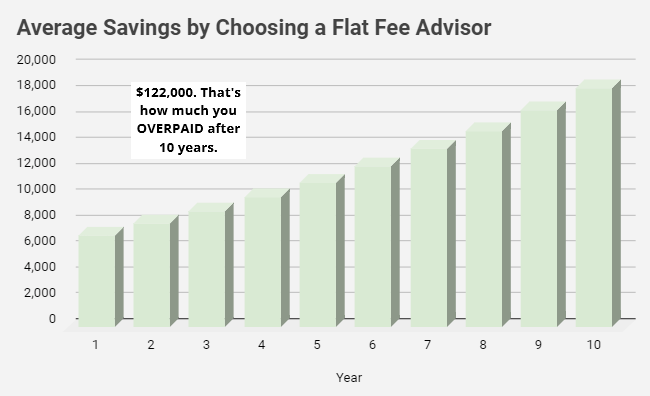Why Flat Fees
Fee-only advisors aren’t equal. After choosing to work with a fee-only advisor, you get to choose how those fees are structured. I’m going to show you how a flat fee structure makes your advisor more honest and leaves you richer and more secure.
Assuming $2 million starting portfolio value. 7% growth rate pre-tax.
0.8% average advisory fee. $10,000 flat fee with 3% annual fee increase.
Average advisory fee source: Kitces.com
Our Fee Structure
We have built an annual flat fee structure to pay us for our expertise and the services that we provide. It does not depend on a client’s portfolio size. We firmly believe that a flat annual fee is better for wealth management.
A primary principle in economics is that people, including advisors, respond to incentives. Our fee structure puts us on the same side of the table as our clients. The right incentives, with our expertise and experience, allow us to give the best advice to our clients.
Conflicts of Interest
Many financial advisory firms claim that they have the same interests as their clients. They say this is the case when they charge a % of the assets they manage. They want the account to perform well and to avoid losses, just like the client. This sounds good, but is far from the truth.
First, most clients’ goals are not to increase the assets held by their financial advisor.
They expect a profitable investment outcome. But, their real goals are to enjoy retirement, feel secure, and leave a legacy.
Why does this distinction matter? Think about the following scenarios. Conflicts could arise due to your advisor’s sole incentive. His only goal is to increase the assets he manages.
- Paying off debt – Many of my clients have a goal to become debt-free. Using investment assets to pay off debt has pros and cons. Deciding if it’s right for you should only involve its effects on you, both financially and emotionally. But, advisors who charge AUM fees have a conflict with a client who wants to remove assets to pay off debt. They will likely provide nearly the same services after the withdrawal. But, their fees will be lower.
- Annuities – here’s a riddle: Most advisors say that compensation is irrelevant. You just do what’s right for the client. Perhaps those advisors can explain to me. Commissioned-based advisors recommend annuities to everyone. But, AUM-based advisors never recommend them. To me the answer is obvious. Advisors on commission make huge commissions by selling annuities. But, advisors who charge AUM fees give up their client’s assets (and their ability to charge AUM fees) when they recommend annuities.
- Gifting – Clients often have gifting goals. They want to see their money at work, rather than waiting to give when they die. That gifting may bring a client great satisfaction, but will bring an AUM-based advisor a hit to his bottom line.
- Spending – Many of my newly retired clients are healthy. They are eager to travel and enjoy their new freedom. Many advisors use clients’ fear of running out of money to get them to live on unreasonably low budgets. An advisor who charges on your assets would love for you to have millions left in your portfolio when you die. For most of my clients, they’d much rather enjoy that money in retirement.
Economies of Scale
Under an AUM-based approach, an investor with $5,000,000 will pay about 10 times what an investor with $500,000 pays. But the same services are performed.
Of course, investors with larger account balances sometimes have need for more services. But I can tell you, based on my experience with hundreds of clients over the years. There is often very little link between the work done and the size of your account.
As a result, if you have a large account balance, you’ll give your advisor an unfair profit margin.
You should enjoy the scale of your large account, not your advisor.
The difference between a typical advisory fee and a flat annual fee over a long period of time can be staggering.

